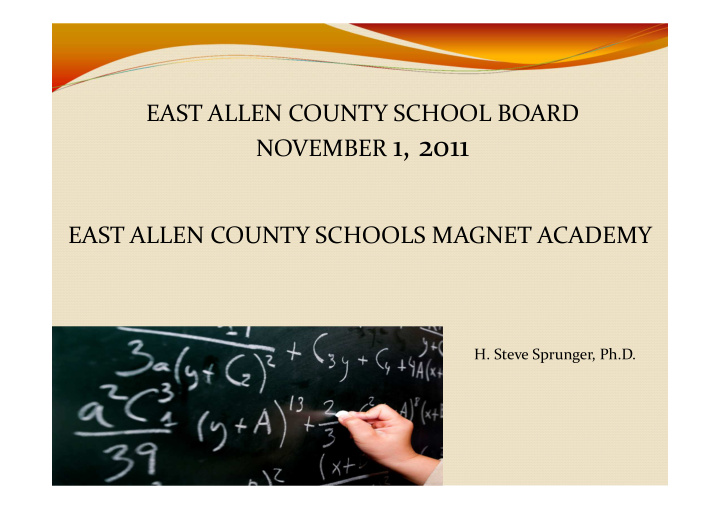



EAST ALLEN COUNTY SCHOOL BOARD NOVEMBER 1, 2011 EAST ALLEN COUNTY SCHOOLS MAGNET ACADEMY H. Steve Sprunger, Ph.D.
East Allen Planning Team Members: Tina Antrim * - Heritage High School John Filutze* – New Haven High School Jennifer Heffernan – Woodlan High School Kevin Jehl- Leo High School Karen Kersey * - New Haven High School Denita Washington *– New Haven High School Doug Hicks - New Haven High School * Previously at Paul Harding High School
� This past spring the Board and Dr. Green had a vision for an academy that would serve as a magnet school for the district at the Paul Harding Campus. � Dr. Green contacted me to see if I had an interest in guiding the planning for creating a magnet academy school which would excel in rigor, relevance, and academic excellence. � The Planning Team was organized with the thought we wanted the professionals closest to the students …teachers, counselors, and building administrators to formulate the very best school possible. � To date, the planning team has researched and reviewed considerable information from various magnet schools, early colleges, met multiple times to consider key concepts, met with select community members to share and solicit thoughts, visited Ben Davis University, met with State Senator Dennis Kruse, and heard presentations from four potential institution of higher learning interested in forming a partnership with East Allen County Schools.
What is an early college Early college high school is a bold approach, based on the principle that academic rigor, combined with the opportunity to save time and money, is a powerful motivator for students to work hard and meet serious intellectual challenges. Early college high schools blend high school and college in a rigorous yet supportive program, compressing the time it takes to complete a high school diploma and the first two years of college. Since 2002, the partner organizations of the Early College High School Initiative have started or redesigned more than 230 schools in 28 states and the District of Columbia. The schools are designed so that low-income youth, first-generation college goers, English language learners, students of color, and other young people underrepresented in higher education can simultaneously earn a high school diploma and an Associate’s degree or up to two years of credit toward a Bachelor’s degree—tuition free.
������������������������������ �������������������������� ������������������������������������������������������� �������������� ������������������������������������ �������������������������������������������������������� ����� ���������������������� �������� ��������������������������������� ������� ������������������������������������������������������ ���� ��������������������������������������������������� ������������������ ���������������������������������� �����������������
1. Early thought - How can we preserve that all students can continue to participate in IHSAA athletics, band and various other traditional extra-curricular programs….Current thought - We value extra-curricular activities, but this school is not about traditional extra-curricular activities, it is about a higher level of study and university level courses. To put it simply, this school cannot be all things to all people. 2. Early thought - The new school is solely responsible for student success….Current thought - Student success begins in kindergarten and builds in each grade level…the freshman must come prepared to succeed in an early college environment. We think this holds huge possibilities for Paul Harding Middle School
Why an early college instead of just more dual credits We desire a university partnership that brings a full time university Dean of Students/Curriculum to the school everyday who works in collaboration with the principal and teachers. This collegiate dean will ensures the courses and instruction are at the university level and meet the requirement of rigor and academic excellence We desire a university partner that brings additional instructional support directly to the students everyday in the form of mentoring, re-teaching, and tutoring of students. (However, it is critical that students also be collaborative learners and independent learners.) We desire an entire school of a handpicked staff from the principal to the last custodian who turns off the lights at night. An entire staff that is passionate and cares deeply that every child learns and succeeds. A staff that is committed to giving every student extraordinary support and understand the importance of rapport and relationships. We desire a school which brings a collegiate feel to the high school campus.
Where are we today in the planning A review of local employment needs indicates a need for a STEM + E curriculum which the planning is committed to. Finalizing the university partnership should happen within the next two weeks and then formalizing this partnership in writing with you the Board. We believe students should graduate from this district magnet school with an associate degree or 62 university credits leading to a four year degree. In November and December course options will be developed in conjunction with the university partner. In November the planning team will be meeting with key members of the Paul Harding community in addition to a broader advisory group.
So Much to be Determined Student application process and selection process; what will they be? Student academic standards to remain enrolled; they need to be set. Can core Indiana standards be matched with university curriculum? Parent or caring adult contract…if yes, what does it look like? Maybe a later starting and ending time (not concerned about ISHAA etc.). Can the school use an interdisciplinary instructional model across various subject matters? What role can the middle school(s) play? How many, how often, and what professional avenues should students be exposed to their freshman and sophomore years? No traditional extra-curricular activities; but, what co-curricular activities? Is it possible to find a name to represent the university aspect of the school?
As We Enter January, February, and March Staff and administrative selection Marketing Student recruitment and selection Student and adult commitments and expectations Programming Professional development.
Recommend
More recommend